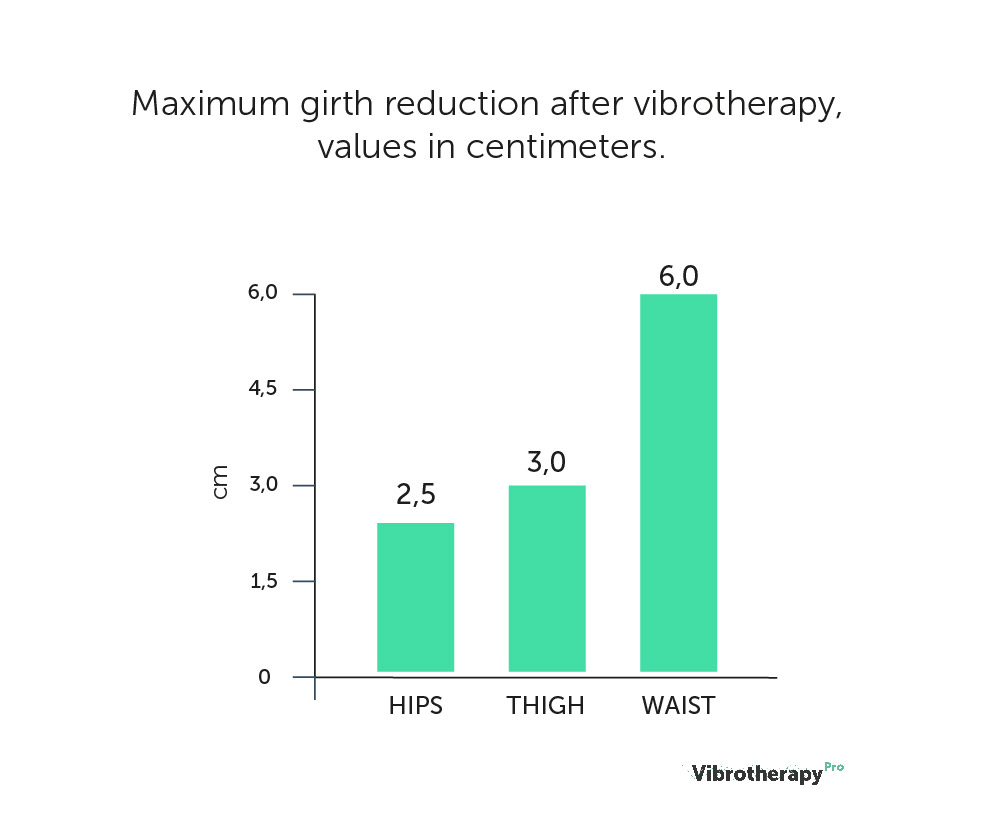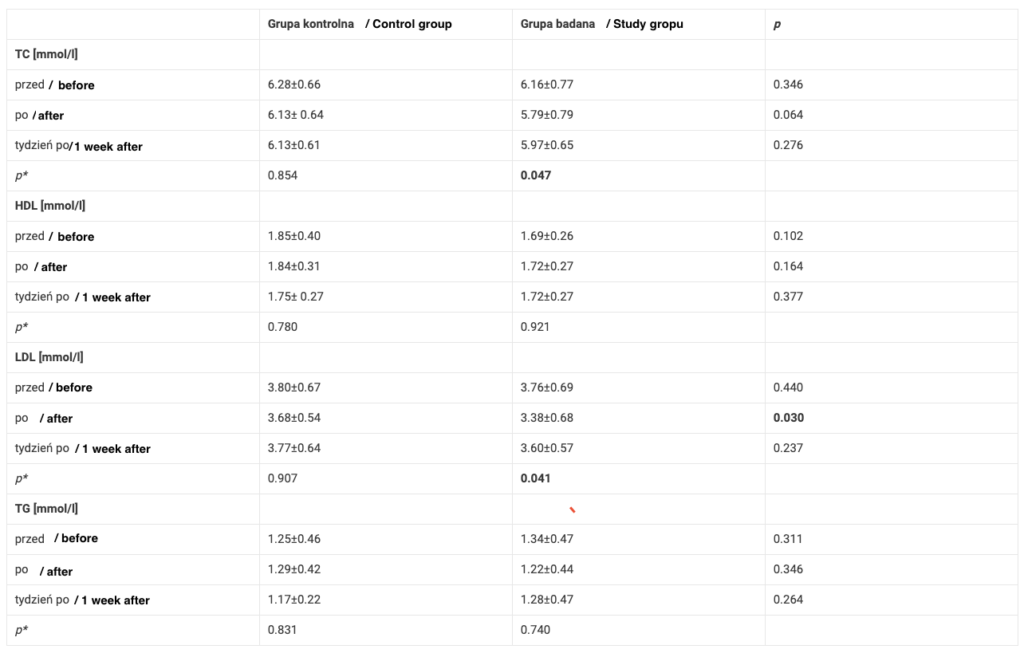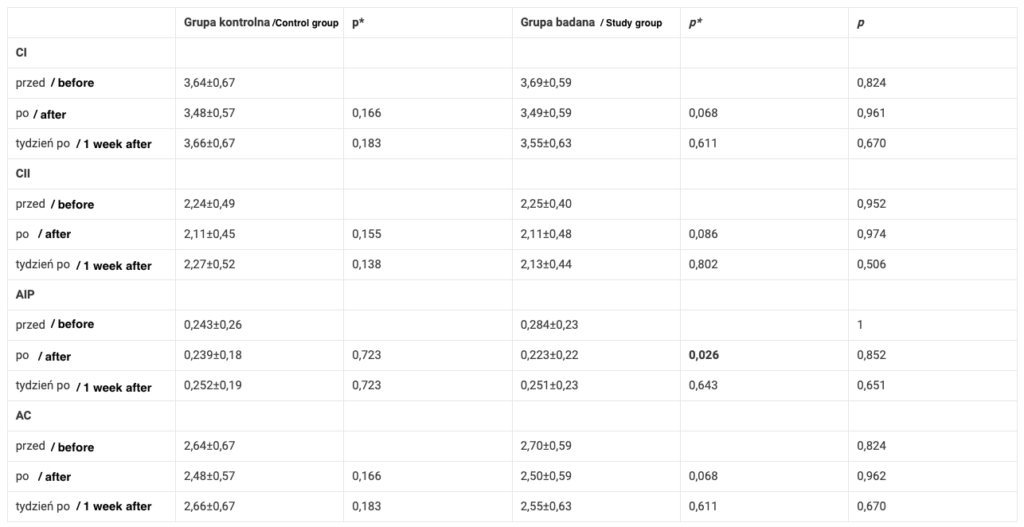After 21 days of oscillatory-cycloid vibration therapy for women over 65, improvements in lipidogram indices were observed
A study of the effect of vibrotherapy, applied in the supine position (vibration carrier: RAM Vitberg+ apparatus, Metabolism module, F Metabolism programme), on the lipid metabolism of the human body. The aim of the study was to indicate the interdependence of the components of the lipid profile, as a factor influencing the condition of the circulatory system. The study confirmed the effect of vibration treatments on changing lipid profile values.
* After 21 days of vibration therapy treatments, there was a significant reduction in total cholesterol (from 6.16 ±0.77 to 5.79 ±0.79) and LDL cholesterol ( from 3.76 ±0.69 to 3.38 ±0.68) in the experimental group.
* In the vibration therapy group, the hip circumference of the female subjects decreased from 107.36 ±5.87 to 106.42 ±5.63.
* The atherogenic (atherosclerotic) indices calculated from the lipid profile improved after the vibration therapy treatments.

Compiled from:

Impact of oscillatory-cycloid vibration interventions on body composition, waist and hip circumference, and blood lipid profile in women aged over 65 years with hypercholesterolaemia. Piotrowska Anna, Bigosińska Monika, Potok Halina, Cisoń Apanasewicz Urszula, Czerwińska Olga, Tota Łukasz, Zuziak Roxana, Pałka Tomasz, Pilch Wanda. Menopause Rev 2018; 17(4): 161-167
Study population
The study included a group of women over 65 years of age, participants of the University of the Third Age in Nowy Sącz, who expressed their willingness in writing to participate in the research project. The following exclusion criteria were applied:
- use of stimulants (in the period of at least two weeks before the start of the study),
- previous use of vibration therapy treatments,
- intake of medications and/or dietary supplements affecting plasma lipid metabolism,
- negative medical qualification for: contraindications to vibration therapy, general assessment of general health,
- high level of physical activity,
- special or exclusion diets currently and up to 3 months prior to the start of the project.
Test procedure
Before and after the treatment series, body composition tests were performed and waist and hip circumferences were measured. Body height, body weight and its individual components were determined using a densitometer (Densytomer GE Healtcare Prodigy, USA). Based on body composition, the densitometer software calculated the A/G Ratio (percentage ratio of android and gynoid fat).
Venous blood for biochemical tests was taken before the start of the treatments (0), on day 21 in the morning, and one week after the end of the treatments, in each case fasting, at least 12 hours after the last meal. Total cholesterol (TC, total cholesterol), triglycerides (TG, triglyceride), HDL fraction cholesterol (HDL, high density lipoprotein cholesterol) and LDL fraction cholesterol (LDL-C, low density lipoprotein cholesterol) were determined from whole blood.
Atherogenicity indices were calculated from the results: CI (Castelli risk index I): TC / HDL-C; C II (Castelli risk index II): LDL-C / HDL-C; TG / HDL; AIP (plasma atherogenic index): log (TG / HDL-C); and AC (atherogenic coefficient): TC – HDL-C / HDL-C.
Use of vibrotherapy in the study
All subjects underwent two 30-minute vibrotherapy treatments 5x per week for a period of 21 days. The women were subjected to vibration therapy, in a supine position, on their abdomen. The treatments were performed twice a day for 30 min each, Monday to Friday, in the morning. The Vitberg+ Rehabilitation Massage Apparatus (RAM Vitberg+ Base Module + Metabolism Module), a Class IIa medical device, was used as the vibration source. The therapeutic stimulus was cycloidal vibration (CV), directed in three perpendicular directions (3D), producing intermittent vibrations with variable values of frequency, amplitude and acceleration, falling within the ranges: f=20-52 Hz, A= 0.1-0.5 mm, a= 6.9-13.5 m/s2.
The control group received identical treatments using specially prepared placebo modules (Vitberg, Poland) in which modifications were made to the actuators. The placebo apparatus looked and produced a sound similar to the active one so as to maintain blinded allocation to the group.
Test results
Vibration therapy, in the supine, abdominal position, using the Vitberg+ Rehabilitation Massaging Apparatus (RAM Vitberg+), applied regularly, had a beneficial effect on lowering total cholesterol and LDL cholesterol levels in people with hypercholesterolaemia. Cycloidal vibration applied regularly for 21 days had a beneficial effect on decreasing atherogenicity indices in women over 65 years of age with diagnosed hypercholesterolaemia. The atherogenic index (atherosclerotic index) is used to determine the inter-relationship of lipids. Exceeding normal data is associated with an increased risk of atherosclerosis.
After 21 days of treatment, the AIP index decreased in the study group.
A reduction in hip circumference was also observed in this group.


Comment
As the results of the study suggest, vibration can be used as a substitute for physical activity. The rhythmic contraction and diastole of skeletal muscles, forced by the vibration application device, triggers a whole-body response and activates numerous muscle groups. The McGee-Lawrence study indicated that vibration training has comparable effects to standardised treadmill training. Its beneficial effects on body weight change, glucose tolerance, muscle fibre status and liver function and steatosis parameters were indicated. Analysing the results of the study, concerning adipose tissue distribution indices, it is possible to indicate a significant effect of oscillatory-cycloidal vibration on reducing only hip circumferences in the women of the experimental group and a tendency to improve atherogenic indices.
However, there were no significant changes in the body composition of the subjects subjected to vibromassage in the supine position, on the abdomen, in contrast to a study where the body composition of healthy subjects and those with type II diabetes was improved, and the therapeutic factor was vibration applied in the standing position.
Vibration treatments are an interesting alternative for people with contraindications to physical activity or who exhibit kinesiophobia, providing the equivalent of physical activity.
More in:

